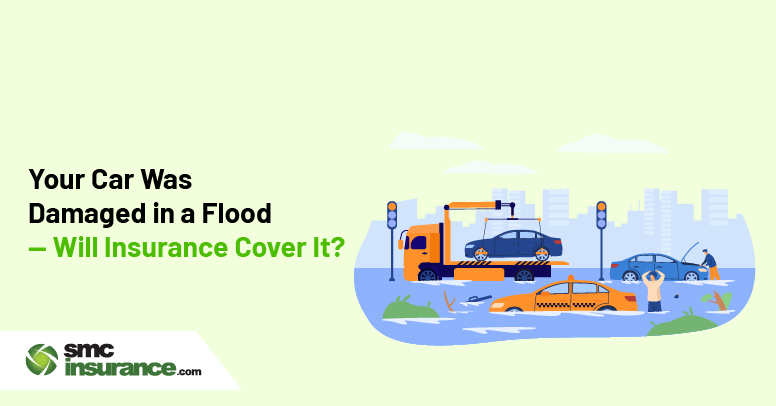If your car is damaged in a flood, insurance will cover it only if you have a comprehensive car insurance policy. This type of policy includes damage caused by natural events such as floods, heavy rain and waterlogging. A third-party policy does not cover damage to your own vehicle.
Engine trouble caused by water often needs an engine protection add-on for full coverage. If your car gets flooded, avoid starting it, record the damage with photos and contact your insurer or broker right away so the claim can be assessed properly.
It was raining cats and dogs that day. By night, the street outside started to go under a muddy, restless current. When the water finally sank back, it left behind broken fences and soggy lawns. But that was not just it. It also had cars, half sunk in silence. You open the door and that smell hits first. Damp seats, mud-streaked carpet.
Now what? Do you call the mechanic or your insurance company first? Does your policy even cover something like this, or is it one of those situations no one mentions until it happens to you?
Floods don’t just test drainage systems; they also test how well you understood your coverage. Some drivers walk away with a repaired car, others with a denied claim and a long regret. The difference often comes down to one overlooked detail on a policy page.
Let’s take a closer look at what really happens when floodwater meets your car, and how insurance decides which side of the story you’re on.
Why Flood Damage is Serious
Floods don’t just wet the interior of a car. They can ruin the engine, the gearbox, electrical wiring, snaps of upholstery and your peace of mind. Here are common issues that flood-hit vehicles face:
- Water in the engine bay: it can damage internal parts, making the vehicle unreliable or worse.
- Electrical short-circuits: water sneaks into wiring, sensors, dashboard panels.
- Interior damage: soaked seats, flooded carpets, damp odours that are hard to remove.
- Gearbox or transmission damage: water entering mechanical parts can lead to malfunction or total loss.
For many owners, flooding results in big repair bills.
Does Car Insurance Cover Flood Damage?
The short answer: Yes, car insurance will cover flood damage but only if you have the right kind of cover.
- If you only have a third-party insurance policy, which is the minimum required by law in India, it won’t cover damage to your own vehicle from floods.
- If you have a comprehensive insurance policy, then yes, flood damage is included under “natural calamities” like floods, cyclones, tsunamis.
In other words: owning comprehensive cover is your best bet when flood-risk is involved.
What Exactly Does a Comprehensive Policy Cover (and What Doesn’t)
It’s important to know every single detail because even comprehensive cover may leave gaps.
Covered under a good plan:
- Damage caused by flood water getting into the vehicle as a whole.
- Natural calamities like storms, heavy rain, floodwater rising around the car.
Not always covered or may require add-ons:
- Engine or gearbox damage due to flooding might need special “engine protection” cover to be fully eligible.
- Replacement of consumables (lubricants, nuts & bolts) may not be automatically covered. But again, this depends on your policy and add-ons.
- Depreciation or partial claims may reduce your payout unless you have “zero depreciation” cover.
What To Do If Your Car Has Been Flood-Damaged?
If your vehicle got impacted by flood water, here are steps that make your claim smoother:
- Don’t start the engine if water has risen significantly. Starting it may cause more damage.
- Document the damage first. Take photographs/videos of the water, car interiors, engine bay, etc.
- Contact your insurer (via your broker or agent) immediately. Inform them of the flood-damage.
- Collect required documents like policy copy, RC (Registration Certificate), driver licence, any other documents your insurer asks for.
- Get your car to an authorised workshop or a garage approved by your insurer. Follow their instructions for claim processing.
At SMC Insurance we’ll walk you through each of these so you’re not left wondering what to do next.
How to Choose the Right Cover (So You’re Ready Before the Flood)
Because being proactive beats dealing with damage later. Live in an area prone to heavy rain or flooding? Choose comprehensive cover without delay. Look at add-on covers that can fill gaps: engine protection, consumables cover, zero depreciation, roadside assistance.
Read your policy’s fine print: what “flood damage” includes, any exclusions, how claims are handled. Keep your policy and documents updated and handy. You can make use of your insurer’s mobile app or even cloud copies work.
Wrapping Up
Flood damage is one of those risks you hope never happens. But when it does, the right insurance cover makes a major difference. At SMC Insurance we believe in helping you pick coverage that fits your risk, your car and your peace of mind. If you’re unsure whether your car cover truly protects you against floods, or if you’re thinking of upgrading your policy, let’s talk. Better safe than stranded.
Disclaimer: The information provided on this platform is intended for general awareness and educational purposes. While every effort is made to ensure accuracy, some details may change with policy updates, regulatory revisions, or insurer-specific modifications. Readers should verify current terms and conditions directly with relevant insurers or through professional consultation before making any decision.
All views and analyses presented are based on publicly available data, internal research, and other sources considered reliable at the time of writing. These do not constitute professional advice, recommendations, or guarantees of any product’s performance. Readers are encouraged to assess the information independently and seek qualified guidance suited to their individual requirements. Customers are advised to review official sales brochures, policy documents, and disclosures before proceeding with any purchase or commitment.








